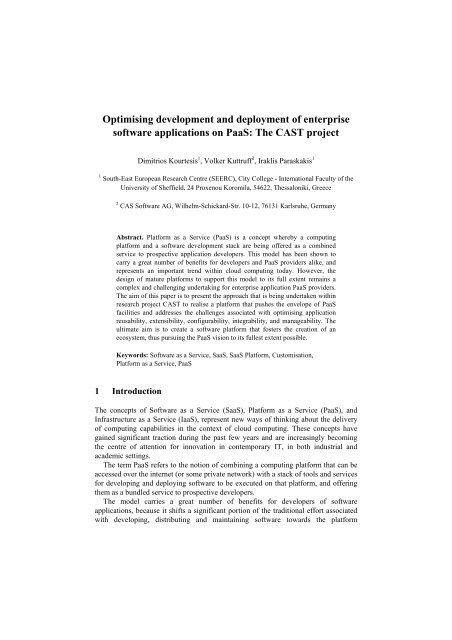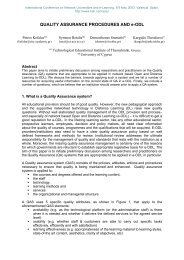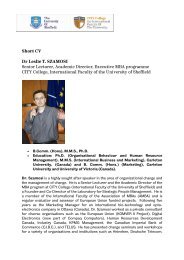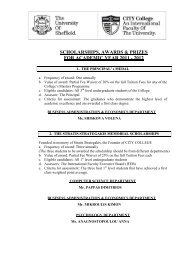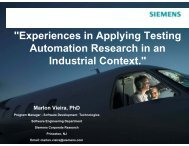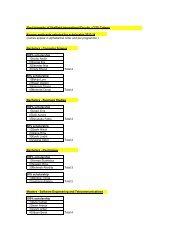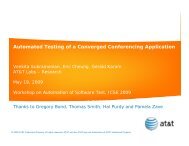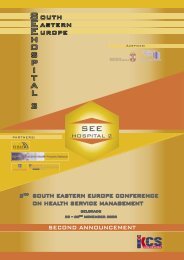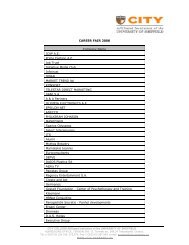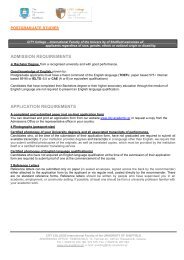Optimising development and deployment of ... - ResearchGate
Optimising development and deployment of ... - ResearchGate
Optimising development and deployment of ... - ResearchGate
You also want an ePaper? Increase the reach of your titles
YUMPU automatically turns print PDFs into web optimized ePapers that Google loves.
<strong>Optimising</strong> <strong>development</strong> <strong>and</strong> <strong>deployment</strong> <strong>of</strong> enterprise<br />
s<strong>of</strong>tware applications on PaaS: The CAST project<br />
Dimitrios Kourtesis 1 , Volker Kuttruff 2 , Iraklis Paraskakis 1<br />
1 South-East European Research Centre (SEERC), City College - International Faculty <strong>of</strong> the<br />
University <strong>of</strong> Sheffield, 24 Proxenou Koromila, 54622, Thessaloniki, Greece<br />
2 CAS S<strong>of</strong>tware AG, Wilhelm-Schickard-Str. 10-12, 76131 Karlsruhe, Germany<br />
Abstract. Platform as a Service (PaaS) is a concept whereby a computing<br />
platform <strong>and</strong> a s<strong>of</strong>tware <strong>development</strong> stack are being <strong>of</strong>fered as a combined<br />
service to prospective application developers. This model has been shown to<br />
carry a great number <strong>of</strong> benefits for developers <strong>and</strong> PaaS providers alike, <strong>and</strong><br />
represents an important trend within cloud computing today. However, the<br />
design <strong>of</strong> mature platforms to support this model to its full extent remains a<br />
complex <strong>and</strong> challenging undertaking for enterprise application PaaS providers.<br />
The aim <strong>of</strong> this paper is to present the approach that is being undertaken within<br />
research project CAST to realise a platform that pushes the envelope <strong>of</strong> PaaS<br />
facilities <strong>and</strong> addresses the challenges associated with optimising application<br />
reusability, extensibility, configurability, integrability, <strong>and</strong> manageability. The<br />
ultimate aim is to create a s<strong>of</strong>tware platform that fosters the creation <strong>of</strong> an<br />
ecosystem, thus pursuing the PaaS vision to its fullest extent possible.<br />
Keywords: S<strong>of</strong>tware as a Service, SaaS, SaaS Platform, Customisation,<br />
Platform as a Service, PaaS<br />
1 Introduction<br />
The concepts <strong>of</strong> S<strong>of</strong>tware as a Service (SaaS), Platform as a Service (PaaS), <strong>and</strong><br />
Infrastructure as a Service (IaaS), represent new ways <strong>of</strong> thinking about the delivery<br />
<strong>of</strong> computing capabilities in the context <strong>of</strong> cloud computing. These concepts have<br />
gained significant traction during the past few years <strong>and</strong> are increasingly becoming<br />
the centre <strong>of</strong> attention for innovation in contemporary IT, in both industrial <strong>and</strong><br />
academic settings.<br />
The term PaaS refers to the notion <strong>of</strong> combining a computing platform that can be<br />
accessed over the internet (or some private network) with a stack <strong>of</strong> tools <strong>and</strong> services<br />
for developing <strong>and</strong> deploying s<strong>of</strong>tware to be executed on that platform, <strong>and</strong> <strong>of</strong>fering<br />
them as a bundled service to prospective developers.<br />
The model carries a great number <strong>of</strong> benefits for developers <strong>of</strong> s<strong>of</strong>tware<br />
applications, because it shifts a significant portion <strong>of</strong> the traditional effort associated<br />
with developing, distributing <strong>and</strong> maintaining s<strong>of</strong>tware towards the platform
2<br />
provider’s end. PaaS <strong>of</strong>ferings are appealing to a wide range <strong>of</strong> types <strong>of</strong> s<strong>of</strong>tware<br />
developers, such as Independent S<strong>of</strong>tware Vendors (ISVs), Value-Added Resellers<br />
(VARs), System Integrators, but also in-house IT teams [1]. The model is<br />
theoretically applicable to applications <strong>and</strong> solutions irrespective <strong>of</strong> size or domain,<br />
but in practice, it appears to have gained widespread adoption especially in the<br />
context <strong>of</strong> enterprise s<strong>of</strong>tware applications [2], primarily due to their inherent<br />
database-centric nature.<br />
Apart from the benefits that the model <strong>of</strong> PaaS brings for s<strong>of</strong>tware developers, it<br />
also carries a great number <strong>of</strong> benefits for prospective PaaS providers. Most<br />
importantly, it ultimately enables platform providers to pursue the creation <strong>of</strong> valueadded<br />
networks <strong>and</strong> the <strong>development</strong> <strong>of</strong> entire business ecosystems around their<br />
platforms, in an analogy to the way current mobile phone platforms like iPhone,<br />
Android <strong>and</strong> Blackberry are operating. This, however, remains largely a vision for the<br />
time being. With a few exceptions (e.g. force.com [3]), the majority <strong>of</strong> today’s PaaS<br />
providers lack the required technical facilities to support this concept to its full extent.<br />
The reason is that the design <strong>of</strong> mature platforms to support this model in an effective<br />
fashion is a particularly complex <strong>and</strong> challenging undertaking for PaaS providers.<br />
CAST is an ongoing research project 1 that is investigating the challenges<br />
associated with this vision <strong>and</strong> aims to develop a commercial platform that can fulfil<br />
this objective. The project is seeking to define an approach for the design <strong>of</strong> a<br />
platform that pushes the envelope <strong>of</strong> configurability <strong>and</strong> customisability, ecosystemcentric<br />
extensibility <strong>and</strong> native multi-tenancy. In the rest <strong>of</strong> this paper we discuss the<br />
key challenges associated with the design <strong>of</strong> such a platform, briefly review the state<br />
<strong>of</strong> practice in the area <strong>of</strong> PaaS <strong>of</strong>ferings relative to those challenges, <strong>and</strong> provide an<br />
overview <strong>of</strong> the CAST platform’s main concepts <strong>and</strong> architecture.<br />
2 Platform maturity levels <strong>and</strong> the state <strong>of</strong> practice<br />
The technology space for PaaS <strong>of</strong>ferings is currently evolving <strong>and</strong> undergoing<br />
changes as it progresses towards higher levels <strong>of</strong> maturity. As usually happens with<br />
concepts that gain wide acceptance before they are fully analysed <strong>and</strong> understood, the<br />
term PaaS has become rather overloaded. Broadly speaking, we can categorise the<br />
PaaS <strong>of</strong>ferings available today in two basic types: technology-specific PaaS, such as<br />
Google App Engine, Micros<strong>of</strong>t Azure, Heroku <strong>and</strong> Engine Yard, <strong>and</strong> domain-specific<br />
PaaS, such as Force.com, LongJump, Zoho Creator <strong>and</strong> WOLF.<br />
Despite the widespread adoption <strong>of</strong> PaaS as a model, it might not be an<br />
exaggeration to claim that, at the moment, only a few <strong>of</strong> the technology providers that<br />
categorise themselves under ‘PaaS’ are actually supporting the concept <strong>of</strong> PaaS to its<br />
full extent, i.e. work with a vision to achieve a true “s<strong>of</strong>tware platform effect” [4] <strong>and</strong><br />
to support the creation <strong>of</strong> actual ecosystems around their <strong>of</strong>ferings.<br />
To facilitate comparison between the multitude <strong>of</strong> <strong>of</strong>ferings <strong>and</strong> supporting<br />
platforms for SaaS/PaaS that are available on the market, attempts have been made to<br />
1<br />
http://www.cast-project.eu
3<br />
develop maturity models based on sets <strong>of</strong> key characteristics. The first attempt was by<br />
Chong <strong>and</strong> Carraro <strong>of</strong> Micros<strong>of</strong>t [5], who tried to define a maturity model for ondem<strong>and</strong>/SaaS<br />
<strong>of</strong>ferings <strong>and</strong> their supporting platforms, along the criteria <strong>of</strong><br />
scalability, multi-tenancy, <strong>and</strong> customisability through configuration. On the basis <strong>of</strong><br />
these characteristics they defined a maturity model consisting <strong>of</strong> four levels:<br />
• Level 0 (ad-hoc/custom): No provision is made to serve multiple tenants 2 from a<br />
single instance <strong>of</strong> server s<strong>of</strong>tware. A separate instance <strong>of</strong> server s<strong>of</strong>tware is<br />
installed for each customer to be served, including any necessary customisations<br />
specific to that customer (such as custom business logic, data schema, UI forms).<br />
This is essentially the same as the traditional Application Service Provider (ASP)<br />
model.<br />
• Level 1 (configurable): Applications are possible to customise via configuration<br />
(i.e. without writing <strong>and</strong> deploying any custom code) in order to fulfil specific<br />
requirements <strong>of</strong> different tenants. This allows all tenants to be served by the same<br />
application codebase. However, a dedicated installation (code-wise identical) is<br />
still being maintained for each customer. This type <strong>of</strong> architecture is not considered<br />
multi-tenant since computing resources are still not shared among s<strong>of</strong>tware<br />
instances. Server space/time must be provided for as many instances as the vendor<br />
has customers.<br />
• Level 2 (configurable, multi tenant): Applications can be customised solely<br />
through configuration, <strong>and</strong> a single instance <strong>of</strong> server s<strong>of</strong>tware can serve all<br />
customers. Compared to the previous level, this allows for much more efficient use<br />
<strong>of</strong> computing resources. However, scalability remains a problem, because the only<br />
way to scale the application up is by moving it to more powerful hardware, at least<br />
for as long as this remains cost-effective.<br />
• Level 3 (scalable, configurable, multi tenant): Applications are featuring all<br />
characteristics <strong>of</strong> the previous level, with the addition <strong>of</strong> load balancing to address<br />
scalability. The number <strong>of</strong> servers <strong>and</strong> instances can be adapted to match dem<strong>and</strong>,<br />
making applications scalable to arbitrarily large numbers <strong>of</strong> customers.<br />
Ried, Rymer <strong>and</strong> Iqbal <strong>of</strong> Forrester Research proposed an alternative maturity<br />
model for cloud computing application platforms comprising six levels [6].<br />
• Level 0 in the Forrester model concerns cases where some form <strong>of</strong> s<strong>of</strong>tware<br />
outsourcing is inaccurately being referred to as SaaS provisioning. By this the<br />
authors are trying to stress that the term should be used with due care to avoid<br />
overloading <strong>and</strong> misinterpretations.<br />
• Level 1 corresponds to the traditional ASP model, i.e. to Micros<strong>of</strong>t’s level 0. A<br />
separate instance <strong>of</strong> server s<strong>of</strong>tware is installed for each customer served.<br />
• Level 2 in the Forrester model corresponds to level 1 in Micros<strong>of</strong>t’s model. It<br />
refers to applications which are customisable via configuration, such that the<br />
codebase can be shared, but where dedicated installations are maintained for<br />
different customers.<br />
2<br />
The term tenant refers to a whole customer organisation/company, not to a single user.
4<br />
• Level 3 corresponds to levels 2 <strong>and</strong> 3 in Micros<strong>of</strong>t’s model. Scalability, multitenancy,<br />
<strong>and</strong> customisability through configuration are considered prerequisites,<br />
similarly to Micros<strong>of</strong>t’s level 3. However, the Forrester model adds an additional<br />
characteristic: the fact that platforms/vendors at this level <strong>of</strong> maturity <strong>of</strong>fer single<br />
well-defined SaaS applications (e.g. a CRM solution).<br />
• Level 4 is for platforms where applications can be extended by additional business<br />
logic through custom extensions (beyond configuration) <strong>and</strong> by third-party<br />
packaged SaaS solutions, thus making it possible to build SaaS applications for<br />
entire business domains.<br />
• Finally, level 5 refers to platforms that satisfy all criteria for level 4, <strong>and</strong> moreover,<br />
are pre-populated with numerous business applications or business services which<br />
can be dynamically composed to create tenant-specific or even user-specific SaaS<br />
business applications.<br />
Considering the state <strong>of</strong> practice in the contemporary PaaS technology <strong>and</strong> market<br />
space [7, 8, 9] relative to the above maturity criteria, it can be noted that most <strong>of</strong><br />
today’s PaaS providers are lacking with regard to support for one or more <strong>of</strong> the<br />
following platform capabilities, which are central to a mature PaaS <strong>of</strong>fering:<br />
1. Support for sharing <strong>of</strong> an application’s codebase or runtime instances by multiple<br />
tenants in order to minimise operational costs for the provider (multi-tenancy)<br />
2. Support for modifying/tailoring applications already deployed on the platform<br />
(through metadata-driven configurability <strong>and</strong>/or code-driven customisability)<br />
3. Support for reusing applications that were developed by third parties as building<br />
blocks for creating completely new applications (ecosystem-centric extensibility)<br />
4. Support for creating applications without restrictions to a particular business<br />
domain such as CRM only (multi-domain applicability)<br />
Lacking with respect to the first platform capability, i.e. enabling a multi-tenant<br />
infrastructure, severely limits the platform provider’s potential to achieve economies<br />
<strong>of</strong> scale, <strong>and</strong> inevitably becomes a roadblock for growth in a cloud computing<br />
context. Lacking with respect to the other three platform capabilities limits the<br />
platform provider’s potential with regard to the emergence <strong>of</strong> a technology <strong>and</strong><br />
business ecosystem around the platform.<br />
3 Summary <strong>of</strong> challenges in the design <strong>of</strong> the CAST platform<br />
The CAST project is working towards the direction <strong>of</strong> a fully-fledged PaaS model. It<br />
is investigating techniques, methods <strong>and</strong> tools for the realisation <strong>of</strong> a s<strong>of</strong>tware<br />
platform that overcomes the abovementioned deficiencies in the current state <strong>of</strong><br />
practice, <strong>and</strong> enables efficient <strong>and</strong> effective <strong>development</strong>, <strong>deployment</strong> <strong>and</strong><br />
provisioning <strong>of</strong> on-dem<strong>and</strong> enterprise s<strong>of</strong>tware applications.<br />
To achieve this goal, the design <strong>of</strong> the CAST platform needs to address two<br />
distinct (but complementary) sets <strong>of</strong> challenges, which shape the platform’s model <strong>of</strong><br />
operation <strong>and</strong> its technical architecture:
5<br />
• Challenges which are generic with regard to cloud infrastructures, such as enabling<br />
multi-tenancy, scalability, reliability, security;<br />
• Challenges which are specific to application platforms, such as facilitating<br />
application reusability, extensibility, configurability, integrability, manageability.<br />
The first set <strong>of</strong> challenges is fundamental to providing any cloud-based service.<br />
The second set is fundamental to providing a service on the basis <strong>of</strong> a PaaS <strong>of</strong>fering.<br />
The focus here is supporting application <strong>development</strong> specifically in the context <strong>of</strong> a<br />
‘s<strong>of</strong>tware platform’ [10, 11, 12], <strong>and</strong> achieving the ‘platform effect’ that has already<br />
become very popular outside the cloud computing domain by mobile phone platforms<br />
such as Apple’s iPhone. Fundamental to this, is to provide facilities which will act as<br />
catalysts for the emergence <strong>of</strong> an actual ecosystem around the platform.<br />
In practical terms, these facilities include enabling application developers to reuse<br />
existing applications found on the platform, adapt them to their needs, integrate them<br />
with external systems, combine them into new solutions <strong>and</strong> resell them, while<br />
keeping the platform provider’s effort for maintaining the platform <strong>and</strong> managing the<br />
application <strong>development</strong>/<strong>deployment</strong> process as low as possible.<br />
4 Main concepts <strong>and</strong> terminology<br />
Before going into further detail with regard to the platform’s model <strong>of</strong> operation <strong>and</strong><br />
architecture, it is best to provide an overview <strong>of</strong> the main concepts <strong>and</strong> associated<br />
terminology. We explain how we use the terms platform, solution, customisation, app,<br />
<strong>and</strong> external service, in the context <strong>of</strong> the CAST project <strong>and</strong> this paper.<br />
Platform<br />
The platform is defined as a s<strong>of</strong>tware environment used for developing, deploying,<br />
<strong>and</strong> provisioning enterprise s<strong>of</strong>tware applications. The usage <strong>of</strong> the platform is<br />
<strong>of</strong>fered as a service to developers who are looking to create Web-based on-dem<strong>and</strong><br />
applications. Those developers can be Independent S<strong>of</strong>tware Vendors (ISVs) who are<br />
looking to create new solutions addressable to entire markets, or IT teams looking to<br />
create solutions for specific needs within their own organisations.<br />
The platform consists <strong>of</strong> an execution stack (hardware, server s<strong>of</strong>tware, databases,<br />
application containers, etc), a set <strong>of</strong> core <strong>and</strong> optional “building blocks” which are<br />
used for developing new applications/solutions, <strong>and</strong> a set <strong>of</strong> specialised tools to<br />
support the activities <strong>of</strong> developers <strong>and</strong> administrators.<br />
The platform adheres to the open/closed principle: it is open for extensions through<br />
changes at explicitly declared components <strong>of</strong> the architecture, <strong>and</strong> closed for any<br />
other modifications that could affect its stability <strong>and</strong> reliability.<br />
Solutions<br />
A solution is defined as an enterprise s<strong>of</strong>tware application which is based on the<br />
platform <strong>and</strong> is targeted at a specific market segment (e.g. CRM for insurance<br />
companies). Solutions are therefore intended to be marketable to a great number <strong>of</strong>
6<br />
potential end users. A solution accounts for domain specific characteristics within its<br />
domain model, its business logic <strong>and</strong> its user interface.<br />
Customisations<br />
A customisation is defined as an application that is based on an existing solution <strong>and</strong><br />
has been tailored to address the needs <strong>of</strong> one specific customer. There exists a one-tomany<br />
relationship between platform, solutions <strong>and</strong> customisations: A platform hosts<br />
many solutions, <strong>and</strong> for each solution, it is possible to provide several customerspecific<br />
customisations.<br />
Apps<br />
Solutions <strong>and</strong> customisations can be regarded as “bundles” consisting <strong>of</strong> finer-grained<br />
components which are called apps. Each app within a solution or customisation<br />
provides a highly-specialised functionality. An app can be data-centric, e.g. providing<br />
the implementation for a new data type, or it can be process-centric, e.g. supporting a<br />
sales employee for performing mass-imports <strong>of</strong> customer addresses.<br />
Apps can (but may not always) affect all <strong>of</strong> the platform’s runtime layers, i.e. by<br />
defining new data object types on the data layer, new business operations on the<br />
business logic layer, <strong>and</strong> new user interface elements on the presentation layer.<br />
An app’s behaviour can be extended by creating so called app extensions which<br />
interface with the app at designated extension points. An app extension is not a<br />
st<strong>and</strong>alone component, but functions as a plug-in to one or more apps. Apps as well as<br />
app extensions can be configurable. Predefined functionality can be enabled, disabled<br />
or adjusted to a certain extent.<br />
External Services<br />
Apps <strong>and</strong> app extensions may rely on external services to deliver part <strong>of</strong> their<br />
functionality. By external services we refer to systems that are deployed externally to<br />
the platform <strong>and</strong> are accessible over the Web, <strong>and</strong> through a programmatic interface<br />
(i.e. Web services).<br />
The ability to use Web services enables the developers <strong>of</strong> solutions <strong>and</strong><br />
customisations to leverage already existing (<strong>and</strong> tested) solutions for particular<br />
highly-specialised tasks within their apps, instead <strong>of</strong> having to reinvent the wheel. For<br />
example, an app or app extension for contact management could invoke an external<br />
service to perform postal address validation for a particular contact, or to obtain stock<br />
quote information for a contact’s company.<br />
Even more importantly, the use <strong>of</strong> Web services in conjunction with apps opens the<br />
possibility <strong>of</strong> integrating solutions that are deployed on the platform with external<br />
organisations <strong>and</strong> service providers, or even with legacy systems.<br />
5 CAST platform outline<br />
We could outline the synthesis <strong>of</strong> the CAST platform by distinguishing among three<br />
main elements within its architecture: the platform’s execution infrastructure, the
7<br />
platform’s governance infrastructure, <strong>and</strong> the platform’s end-user directory. In the<br />
following we outline the main functionalities <strong>of</strong> each element.<br />
5.1 Runtime infrastructure<br />
The runtime infrastructure <strong>of</strong> the CAST platform comprises three layers:<br />
• Data layer: The data layer provides an abstraction over the physical database <strong>and</strong><br />
facilitates secured access to the data objects stored therein. It provides basic CRUD<br />
(Create, Retrieve, Update, Delete) operations on objects, while enforcing<br />
permissions, checking constraints <strong>and</strong> creating journal entries. The stored objects<br />
instantiate the platform’s st<strong>and</strong>ard domain model, whose schema can however be<br />
manipulated through a set <strong>of</strong> st<strong>and</strong>ard operations in order to create new data types.<br />
Schema customisations are stored in a way which ensures that multi-tenancy does<br />
not prohibit upgradability <strong>and</strong> scalability.<br />
• Business logic layer: The business logic layer is where domain-specific business<br />
functions are implemented. The platform’s business logic can be extended by<br />
creating Event-Condition-Action rules that realise custom logic <strong>and</strong> are evaluated<br />
by a rule engine at runtime, or by providing customised business logic through<br />
Web services that are external to the CAST platform. For the first option, the<br />
platform provides a set <strong>of</strong> predefined events <strong>and</strong> a set <strong>of</strong> predefined actions. For the<br />
second option, the platform provides a configurable framework for external service<br />
invocation which can also be extended through custom plugins.<br />
• Presentation layer: The presentation layer facilitates interaction with the user: it<br />
presents information from the data layer, <strong>of</strong>fers actions to execute business logic<br />
operations <strong>and</strong> accepts user input for creating, editing or deleting data. It is<br />
conceptually part <strong>of</strong> the platform’s runtime infrastructure, but it is actually<br />
executed completely on the client’s side. The RIA framework that is used for its<br />
implementation is Micros<strong>of</strong>t Silverlight. Silverlight emphasises the concept <strong>of</strong><br />
separating user interface structure <strong>and</strong> presentation logic, <strong>and</strong> adopts a declarative<br />
approach to defining user interfaces as compositions <strong>of</strong> st<strong>and</strong>ard <strong>and</strong> custom<br />
controls in an XML-based language (XAML).<br />
5.2 Governance infrastructure<br />
The governance infrastructure comprises a registry/repository system that serves as a<br />
central location in which entities <strong>and</strong> artefacts that are necessary to the operation <strong>of</strong><br />
the CAST platform are stored, organised, <strong>and</strong> managed throughout their lifecycle. It<br />
provides a space <strong>and</strong> a set <strong>of</strong> functions for enabling the effective governance <strong>of</strong><br />
entities <strong>and</strong> artefacts from creation to retirement.<br />
Governance is supported by providing specialised tools which assist the users <strong>of</strong><br />
the system (i.e. platform administrators <strong>and</strong> solution/customisation developers) in<br />
performing st<strong>and</strong>ard (manual) quality assurance tasks, but also, by providing tools<br />
that automate a number <strong>of</strong> quality controls by applying conformance checking <strong>and</strong><br />
data validation with regard to platform governance rules.
8<br />
Specifically, the registry/repository system supports the following functions:<br />
• Central cataloguing <strong>of</strong> solutions, apps, <strong>and</strong> external services, <strong>and</strong> storage <strong>of</strong> their<br />
associated artefacts in platform-wide accessible location.<br />
• Versioning <strong>of</strong> managed entities <strong>and</strong> artefacts to reflect significant changes <strong>and</strong> to<br />
designate new states in <strong>development</strong>.<br />
• Controlling the evolution <strong>of</strong> managed entities <strong>and</strong> artefacts, by modelling lifecycle<br />
states <strong>and</strong> associating validation checks with state transitions.<br />
• Tracking dependencies among solutions, apps, <strong>and</strong> services <strong>and</strong> allowing for<br />
impact analysis.<br />
• Performing conformance checking to ensure that managed entities <strong>and</strong> artefacts are<br />
compliant to the platform provider’s ground rules regarding valid structures.<br />
• Monitoring <strong>of</strong> the external Web services on which apps are dependent to ensure<br />
appropriate levels <strong>of</strong> availability <strong>and</strong> performance, considering SLAs.<br />
5.3 App/solution directory (store)<br />
An app/solution directory is an end-user facing Web application that allows customers<br />
to view the solutions <strong>and</strong> apps that are available on the CAST platform. Users can<br />
select a solution, view all apps that are compatible with the particular solution,<br />
enable/disable optional apps, <strong>and</strong> install them to their account, triggering all necessary<br />
licensing/billing/configuration steps through st<strong>and</strong>ardized wizards. Input for these<br />
wizards can be extracted from app metadata (app/solution manifest) that were written<br />
to the registry/repository during app <strong>deployment</strong>.<br />
Installation <strong>of</strong> an app in the CAST context does not mean that native code <strong>and</strong><br />
artefacts are deployed / installed to a special location. Installation means unlocking<br />
the functionality <strong>of</strong> an app for a specific user. During installation <strong>of</strong> an app, the<br />
database schema specifications will be applied (e.g. new tables will be created or<br />
existing tables will be extended). Furthermore, other artefacts <strong>of</strong> the app will be<br />
interpreted from this point on. This also holds for native code: dispatchers in the<br />
CAST platform core will call the associated native code components after an app has<br />
been unlocked for the user. This also means that native code parts <strong>of</strong> an app are<br />
always part <strong>of</strong> the CAST platform's code base, but they will not be invoked until an<br />
app is explicitly installed.<br />
6 CAST platform packaging model<br />
Apps are the basic blocks for creating enterprise s<strong>of</strong>tware solutions <strong>and</strong><br />
customisations within the CAST platform. There can be apps that are pre-fabricated<br />
by the CAST platform provider (e.g. built-in apps for basic functionalities like contact<br />
management or document management) <strong>and</strong> are subsequently configured by a<br />
platform partner for a particular solution or customisation, or apps which are<br />
developed by a platform partner from the ground-up, <strong>and</strong> subsequently added to the<br />
platform for other partners to reuse <strong>and</strong> customise for their own solutions.
9<br />
Every solution or customisation is a package which consists <strong>of</strong> a set <strong>of</strong> apps, as<br />
well as a number <strong>of</strong> artefacts that determine how these apps are to be combined <strong>and</strong><br />
executed by the platform’s runtime infrastructure. Those artefacts are primarily used<br />
for defining solution-specific constraints on the apps involved. Since an app can be<br />
part <strong>of</strong> more than one solution, different constraints can be active for a particular app<br />
depending on the execution context. An example for such a constraint is a domainspecific<br />
or tenant-specific reduction <strong>of</strong> the valid range <strong>of</strong> a value (which may be<br />
unbounded in the general data model for an app).<br />
Fig. 1. Example <strong>of</strong> packaging a CRM solution for insurance companies<br />
Figure 1 shows an example <strong>of</strong> a CRM solution addressed to insurance companies.<br />
The solution reuses four pre-fabricated apps (Address management, Document<br />
management, Email management <strong>and</strong> Calendar management) which have been<br />
developed by the provider <strong>of</strong> the CAST platform. Additionally, the solution developer<br />
creates four solution-specific apps: two data-centric apps for the new Insurance policy<br />
<strong>and</strong> Seminar data object types, <strong>and</strong> two process-centric apps for Insurance Policy Renegotiation<br />
<strong>and</strong> Importing <strong>of</strong> Insurance Policy Data (for performing mass imports<br />
from third party systems).<br />
In addition, two app extensions are employed to extend the functionality <strong>of</strong> the<br />
Address management, Document management <strong>and</strong> Email management apps. The<br />
Organisation structuring app extension automatically links address objects that belong<br />
together (e.g. for a subsidiary company) within the Address management app. The<br />
Coverflow app extension extends the user interface <strong>of</strong> the Document management <strong>and</strong><br />
Email management apps by allowing the user to visually flip through snapshots <strong>of</strong> the<br />
contents <strong>of</strong> the corresponding data objects using three-dimensional animation.
10<br />
7 CAST platform <strong>deployment</strong> model<br />
The way in which solutions <strong>and</strong> customisations are deployed on the platform differs,<br />
depending on the artefacts/code that come with their associated apps, <strong>and</strong> how the<br />
latter are deployed to the runtime infrastructure.<br />
Within CAST, we distinguish between three types <strong>of</strong> apps with respect to their<br />
method <strong>of</strong> <strong>deployment</strong>: purely declarative apps (type 1), apps that involve code<br />
execution at the client-side (type 2), <strong>and</strong> apps that involve code execution at both<br />
client-side <strong>and</strong> server-side (type 3). The increasing numbering <strong>of</strong> app types denotes<br />
increasing capabilities but also increased <strong>deployment</strong> complexity. This concept<br />
applies not only to apps, but to app extensions as well.<br />
7.1 Type 1: Purely declarative apps<br />
A major objective for the CAST platform is to promote declarative configurations<br />
over native code. If an app is created using declarative specifications only, it is<br />
classified as type 1. Such apps can be deployed during normal execution <strong>of</strong> the CAST<br />
platform, without the need to stop <strong>and</strong> resume any subsystems or affect any active<br />
users. During <strong>deployment</strong> to the platform’s runtime infrastructure, a type 1 app<br />
comprises the following (not necessarily all) types <strong>of</strong> XML-based artefacts:<br />
• Database schema descriptions, for extending already existing data object types or<br />
defining new ones.<br />
• Declarative specifications <strong>of</strong> data validators employed to enforce constraints on<br />
data object types.<br />
• Definitions <strong>of</strong> custom UI elements (XAML-based), page flows, <strong>and</strong> mappings from<br />
page types to forms.<br />
• Extensions to business logic through definitions <strong>of</strong> data-centric rules, or declarative<br />
specifications <strong>of</strong> invocations to external Web services.<br />
• Definitions <strong>of</strong> translation/localisation resources.<br />
• Specifications <strong>of</strong> app extension points.<br />
In addition, each app comes with a manifest that describes additional important<br />
properties, such as dependencies on other apps, version information, provider<br />
information, licensing information, pricing information, etc.<br />
7.2 Type 2: Client-side code apps<br />
Type 2 apps <strong>of</strong>fer all <strong>of</strong> the possibilities that are provided by apps <strong>of</strong> type 1, <strong>and</strong> in<br />
addition, include the possibility to use native code which is deployed <strong>and</strong> executed at<br />
the client’s machine. In the CAST platform, this is C# code that is intended for<br />
runtime <strong>deployment</strong> to a Silverlight runtime instance within the client’s browser<br />
(making use <strong>of</strong> Silverlight’s ability for dynamic loading <strong>of</strong> libraries from a Web<br />
server). This allows the <strong>deployment</strong> <strong>and</strong> execution <strong>of</strong> customised comm<strong>and</strong> h<strong>and</strong>lers
11<br />
for implementing new custom client logic, customised Model/ViewModel<br />
implementations <strong>and</strong> new custom controls.<br />
Since the presentation layer <strong>of</strong> the CAST platform executes on the user's machine<br />
within a Silverlight plug-in, security risks are lower compared to code that runs within<br />
the CAST platform’s application servers. In case a type 2 app crashes, the only user<br />
that is affected is the one currently using the app. However, to prevent potential<br />
problems with bugs causing crashes to client machines <strong>and</strong> creating a negative impact<br />
with regard to the platform’s reputation, type 2 apps need to undergo a review <strong>and</strong><br />
certification process by the platform provider for quality assurance. Due to the<br />
presence <strong>of</strong> native code to be reviewed, this requires substantially more effort<br />
compared to conducting review <strong>and</strong> certification for purely declarative apps (type 1).<br />
7.3 Type 3: Client-side <strong>and</strong> server-side code apps<br />
Type 3 apps enable customisation <strong>and</strong> extensibility to the fullest extent possible with<br />
the CAST platform. In addition to declarative customisations <strong>and</strong> native code to be<br />
executed at the client’s side, type 3 apps include the possibility to write native code to<br />
be executed by the CAST platform’s application servers. To that end, the CAST<br />
platform runtime defines dedicated extension points to enhance the existing<br />
functionality that is built-in to the platform.<br />
This further allows developers to implement customised business logic for their<br />
apps that is impossible to express using the platform’s facility for data-centric rules,<br />
<strong>and</strong> providing totally new business operations that are registered within the CAST<br />
platform application servers <strong>and</strong> can be called from clients upon request.<br />
Since the server-side code <strong>of</strong> type 3 apps runs within the same execution context as<br />
the core CAST platform, the latter’s stability can be seriously threatened. Thus, apps<br />
<strong>of</strong> type 3 can only be deployed to the CAST platform application servers by the<br />
platform provider. Prior to this <strong>deployment</strong>, type 3 apps need to be reviewed <strong>and</strong><br />
certified, similarly to apps <strong>of</strong> type 2.<br />
The <strong>deployment</strong> <strong>of</strong> a type 3 app is a lengthy process. On the one h<strong>and</strong>, this is due<br />
to the review, testing <strong>and</strong> certification processes. On the other h<strong>and</strong>, a <strong>deployment</strong> <strong>of</strong><br />
new native server code requires a shutdown <strong>of</strong> the application servers. Shutting down<br />
<strong>and</strong> restarting the platform can only happen when it is necessary to perform important<br />
maintenance activities, or to deploy new platform releases.<br />
8 Conclusions<br />
The model <strong>of</strong> Platform as a Service (PaaS), whereby a computing platform <strong>and</strong> a<br />
s<strong>of</strong>tware <strong>development</strong> stack are being <strong>of</strong>fered as a combined service to prospective<br />
application/solution developers, represents an important trend within cloud computing<br />
today. The PaaS model carries a great number <strong>of</strong> benefits for developers <strong>and</strong> PaaS<br />
providers alike. However, the design <strong>of</strong> a mature platform to support such a model to<br />
its fullest extent possible is a rather complex <strong>and</strong> challenging undertaking in which<br />
the majority <strong>of</strong> today’s PaaS providers face several difficulties.
12<br />
In this paper we introduced the approach that is put forward in the CAST project<br />
for the realisation <strong>of</strong> a platform that overcomes the deficiencies in the current state <strong>of</strong><br />
practice around PaaS <strong>of</strong>ferings. The project works towards the direction <strong>of</strong> a fullyfledged<br />
PaaS model <strong>and</strong> is tackling problems beyond the classic challenges associated<br />
with cloud infrastructures (multi-tenancy, scalability, reliability, security), going into<br />
platform-specific challenges such as optimising application reusability, extensibility,<br />
configurability, integrability, <strong>and</strong> manageability, such that an ecosystem can<br />
eventually emerge around the platform.<br />
The paper provides an overview <strong>of</strong> the main concepts associated with the CAST<br />
platform <strong>and</strong> the <strong>development</strong> <strong>of</strong> applications based upon it, an outline <strong>of</strong> its core<br />
elements <strong>and</strong> their functionalities, a discussion about the model by which solutions<br />
<strong>and</strong> customisations are packaged, <strong>and</strong> an analysis <strong>of</strong> the model by which applications<br />
are deployed on the platform.<br />
Acknowledgments. This work has been carried out in the context <strong>of</strong> research project<br />
CAST, co-funded by Eureka Eurostars (E! 4373), the European Community, the<br />
Greek General Secretariat for Research <strong>and</strong> Technology (15627/4-8-09), <strong>and</strong> the<br />
German Federal Ministry for Education <strong>and</strong> Research.<br />
9 References<br />
1. Natis, Y.V.: Introducing SaaS-Enabled Application Platforms: Features, Roles <strong>and</strong> Futures.<br />
Gartner Inc (2007)<br />
2. Knipp, E., Natis, Y.V.: The Coming Enterprise Shift to an APaaS-Centric Web. Gartner<br />
Inc. (2009)<br />
3. Force.com: Create <strong>and</strong> Run any Application, On Dem<strong>and</strong>. Salesforce.com Inc (2007).<br />
4. Evans, D.S., Hagiu, A., Schmalensee, R.: Invisible Engines: How S<strong>of</strong>tware Platforms Drive<br />
Innovation <strong>and</strong> Transform Industries. MIT Press (2006).<br />
5. Chong, F. Carraro, G.: Architecture Strategies for Catching the Long Tail. MSDN Library,<br />
Micros<strong>of</strong>t Corporation (2006)<br />
6. Ried, S., Rymer, J.R., Iqbal, R.: Forrester's SaaS Maturity Model. Forrester Research<br />
(2008)<br />
7. Lawton, G.: Developing S<strong>of</strong>tware Online With Platform-as-a-Service Technology. IEEE<br />
Computer, vol. 41, no. 6, pp. 13—15 (2008)<br />
8. Leavitt, N.: Is Cloud Computing Really Ready for Prime Time? IEEE Computer, vol. 42,<br />
no. 1, pp. 15—20 (2009)<br />
9. Natis, Y.V., Knipp, E., Pezzini, M., Valdes, R.: Cool Vendors in Application Platforms as a<br />
Service. Gartner Inc. (2010)<br />
10. Meyer, M.H., Seliger, R.: Product Platforms in S<strong>of</strong>tware Development. Sloan Management<br />
Review, vol. 40, no. 1, pp. 61--74 (1998)<br />
11. Evans, D.S., Hagiu, A., Schmalensee, R.: A Survey <strong>of</strong> the Economic Role <strong>of</strong> S<strong>of</strong>tware<br />
Platforms in Computer-based Industries. CESifo Economic Studies, vol. 51, no. 2, pp. 189-<br />
-224 (2005)<br />
12. Wainewright, P.: Redefining S<strong>of</strong>tware Platforms: How PaaS Changes the Game for ISVs.<br />
Procullux Media Limited (2009)


